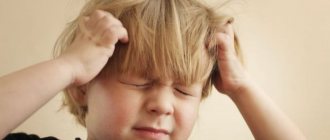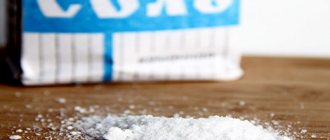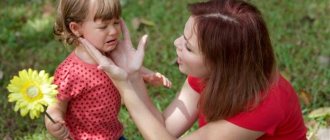The advisability of using drugs for hyperactivity in children is periodically questioned. To understand, you need to define the very concept of hyperactivity syndrome.
Attention deficit hyperactivity disorder is a disorder of higher nervous activity that is often diagnosed in young children. Complications during pregnancy or childbirth can provoke the development of this condition in a child.
A child suffering from hyperactivity has great difficulty concentrating and also finds it difficult to control his behavior. This is due to the fact that the child’s nervous system has difficulty processing incoming information. At the same time, persuasion and punishment have practically no effect - the hyperactive child remains impulsive and restless.
What is hyperactivity
ADHD is one of the most common pathologies that leads to behavioral and learning difficulties. Occurs in 4.0 - 9.5% of children of senior preschool and school age. Caused by brain damage and subsequent dysfunction. It manifests itself as increased excitability, excessive speech and motor activity, decreased attention, and impulsivity.
Characterized by emotional instability and nervous tension, which leads to behavioral disorders and excessive mobility. But this is not a problem of upbringing, but a preschooler’s need to relieve tension. The little person is not to blame - due to the peculiarities of the functioning of the brain, he does not know how and cannot behave differently.
However, the way a hyperactive child behaves causes a lot of inconvenience. First to the mother, then to the educators, kindergarten teachers and teachers. Conflicts with peers are possible. As a result, complexes and psychological problems arise.
If a diagnosis is made in time and corrective work begins, the behavior of children can be corrected in such a way that they can learn, get an education, adapt to a team and lead a normal life in society. Without timely help, behavioral disorders persist into adolescence and adulthood and interfere with normal socialization.
general information
Hyperactivity is a multifaceted disorder of certain brain functions associated with excessive production of nerve impulses.
This pathology becomes the main reason for the child’s excessive activity, which prevents him from concentrating his attention and his own emotions.
The symptoms of hyperactivity may resemble neuroses or the behavior of an ordinary active baby . Only a qualified specialist can recognize the true signs of this condition based on a comprehensive examination.
ADHD - signs
Not every active child is hyperactive. To make a diagnosis of ADHD, the following symptoms must be present (they are called a triad):
- impulsiveness;
- hyperactivity;
- attention deficit and absent-mindedness.
The first symptoms appear in middle or older preschool age, rarely after 7 years. It is during this period that problems in education and training appear. It is difficult for the baby to concentrate on classes; he lacks perseverance and independence.
Depending on which symptom predominates, two subtypes are distinguished: with increased activity and with attention deficit. When both characteristics are present in equal measure, they speak of a mixed subtype. Let's look at these subtypes in more detail:
- A hyperactive child is overly active. Perseverance is not his strong trait. Almost constantly in motion: standing up, running, spinning. Even when he just sits, he shudders, dangles his legs and arms. Movements are not always purposeful. He is not a fan of quiet games. He also finds it difficult to restrain himself when he has to wait his turn in a game. A preschooler or schoolchild constantly shouts out the answer from their seat in class, without even listening to the question. In addition, interfering in other people's conversations, interrupting other guys, talking a lot is a common thing for them;
- A preschooler with attention deficit disorder often makes mistakes and cannot concentrate on one thing. From the outside it seems that he does not hear or listen when other people turn to him, that he is careless. Attention is scattered, which makes it impossible to complete tasks and complete the work started. Even when there are specific instructions for the steps, difficulties arise: when completing tasks, doing housework. And there’s no need to talk about independent study - the preschooler is constantly distracted. He is especially stressed by tasks that require mental effort. Any noise, conversation - he immediately switches to them. He may lose things, but does not even remember where and how it happened.
To be diagnosed with ADHD, a little person must have at least 6 of the listed symptoms for six months or more.
Pantogam in tablets and syrup
Pantogam is a drug based on gamma-aminobutyric acid. This substance controls inhibition processes in the brain. It is available in the form of syrups or tablets for oral use.
You can take the drug 30 minutes after your next meal. You should not take the medicine at night - your child may have problems falling asleep. The dosage is prescribed by a neurologist depending on the age of the child.
The duration of treatment can range from several months to six months. Then it is recommended to take a break for 3-6 months, after which the course can be repeated if necessary.
The effect of taking the drug can be increased with the help of complex treatment. While taking the medicine, there is a decrease in the child’s signs of anxiety or hyperactivity, and an increase in perseverance and ability to concentrate. In addition, the drug affects the pathological activity of brain neurons and has an anticonvulsant effect.
Tags:Hyperactivity
We also recommend reading on this topic:
- What is sex education for teenagers?
- Why do parents hit their children?
- Possible consequences of punishing children with a belt
- Main types of children's fears
2 comments
- Anna Boyko You don’t always want to torture your child with unpleasant drugs or painful injections. Everything worked out for us, the baby formula course with glycine helped. These are vitamins in the form of gummy bears; it is a pleasure for a child to eat them. The composition of magnesium and lemon balm is very good. makes the child more diligent
Answer
- Barbara What is the name of the drug please write more precisely
Answer
How hyperactive children behave
Hyperactive preschool children behave differently compared to their peers. The mother may notice the first symptoms already in infancy. Babies begin to roll over, crawl, and then sit up and walk earlier. Despite their activity, they do not fall asleep from fatigue, but become overexcited and begin to act up. As they get older, they constantly strive to climb somewhere, open something, touch something. They do not realize the danger of their actions.
The sleep is short. At the same time, the baby has difficulty falling asleep, sleeps lightly, and wakes up from any rustle. He cannot fall asleep on his own after waking up; his mother has to rock him to sleep for a long time.
An unfamiliar environment, strangers, noise, loud sounds are an additional irritating factor. Under these conditions, the baby becomes overexcited and begins to act up. Even in a calm environment, a baby cannot hold his attention on one toy for a long time: he is quickly distracted by another.
As a schoolchild, a hyperactive child himself does not study, interferes with lessons, distracts classmates, and sets a negative example for others. Gradually, as you grow older, the signs fade, but do not disappear completely. The person remains mobile, fussy, impulsive: he commits rash actions, it is difficult for him to reason logically.
Attention deficit manifests itself as an inability to complete tasks at school and at home. This becomes noticeable when he is left without outside help: without hints, the student cannot cope with a single task. It is difficult for him to do those exercises where perseverance and attentiveness are required, and those where you need to make an effort and think. On the contrary, they can succeed in games and dynamic activities.
In adolescence, the disturbances are not as pronounced. But still, teenagers, unlike their peers, are dependent, irresponsible, reckless, and not inclined to obey social norms of behavior. At the same time, they are driven, so they often end up in bad company and commit crimes.
In 20 - 35% of patients, the manifestations of ADHD persist into adulthood and are manifested by absent-mindedness, forgetfulness, lack of initiative, and inability to complete the task started. Frequent problems in personal life are typical.
Diagnosis of hyperactivity in children
Symptom assessment
Attention
Assessed by how long the child continues to do something, including drawing, reading, playing alone or with a friend. Pay attention to the frequency of switching from one task to another or between different activities. Hyperactive children cannot do even interesting things for a long time.
Physical activity
They are assessed by how long the child can sit during the activities indicated above in the first paragraph. They also take into account what proportion of the time he fidgets and tries to get up; how often he runs away during family walks or in the store.
Differential diagnosis
Normality
Parents may consider inattentiveness and restlessness abnormal when in fact they are within the normal range.
Situational hyperactivity
Some kids are hyperactive only at home or only in kindergarten. They cannot be diagnosed with hyperactivity. Some researchers still believe that situational hyperactivity is a milder version of persistent hyperactivity.
Behavioral disorders
They are often combined with real hyperactivity, but sometimes they can only imitate it. Children may exhibit abnormalities in only one area, so it is important whether restlessness and inattention persist during selected activities, such as reading, drawing, playing with peers, or building Legos. If so, mixed hyperactivity/conduct disorder is suspected.
Emotional disorder
Severe anxiety, mania, and depression can lead to restlessness and inattention. If the child is hyperactive and has emotional symptoms, a more thorough history is taken to determine what started first. If emotional symptoms appear first, the child is suspected of having an emotional disorder. But if there were symptoms of hyperactivity at first, then this may turn out to be an acute emotional disorder on top of the hyperactivity.
Tics, chorea and other dyskinesias
They can be mistakenly confused with fidgeting. You should carefully monitor your movements. Children with tic disorders may also be hyperactive, and hyperactivity may appear long before the onset of tics.
Autism Spectrum Disorders
They are suspected in cases where inattention and restlessness are accompanied by social impairments, rigid and repetitive behavior of an autistic nature, communication deviations, and a lack of spontaneous symbolic play.
Generalized learning disability
In such a child, attention and regulation may be adequate for mental age, but reduced relative to his chronological age. Children with generalized learning disabilities are also hyperactive (many of them).
Hyperactivity and child's temperament
It is necessary to distinguish between a hyperactive child and a normally active one. Both groups of children are mobile, but their innate temperament, in which there are no disorders of brain function, is characterized by the following distinctive features:
- normal falling asleep, sufficient and sound sleep. If he wakes up, he goes back to sleep without rocking, using his mother’s breast;
- activity and outdoor games do not affect the general condition. After them, the guys calm down on their own and quickly fall asleep;
- the child is aware of his actions, understands that he can be dangerous, avoids them, and experiences fear;
- understands the words “no” and “cannot”;
- communicates calmly with other children, which is important in kindergarten, and shares his toys;
- does not show aggression towards people;
- activity does not interfere with normal development, including mental development, and communication with other people.
What to do if you are diagnosed with this?
The reaction of parents to the diagnosis of hyperactivity in a child can be ambiguous. Some of them feel panic, others believe that the increased activity will go away on its own after adolescence.
Both opinions are wrong. If the diagnosis is confirmed, then the child needs qualified and comprehensive help.
Therapy can last for years. Parents need to be patient and follow all recommendations of specialists.
If a child is hyperactive, parents need to do the following :
- conduct a comprehensive examination of the child and confirm the diagnosis;
- create the most favorable conditions for the child;
- learn to control your emotions and pay attention to your actions;
- follow all prescribed procedures;
- use the help of a psychologist and psychotherapist.
How do you remove lice from children? Read about it here.
Causes of pathology
Research is ongoing regarding risk factors. Most experts believe that in hyperactive preschool children, the cause of disorders may be brain damage.
This can happen both in the prenatal and postnatal periods:
- Prenatal factors of ADHD - toxicosis, threat, unhealthy diet, polyhydramnios, mother's bad habits, mother's illnesses (infectious ones are especially dangerous), stress, occupational hazards, intrauterine neuroinfections, birth trauma, toxins (heavy metals, synthetic and plant toxins), hypoxia, rhesus -conflict;
- Postnatal factors - premature birth, immaturity of brain structures, intrauterine growth retardation, birth asphyxia, peculiarities of upbringing, deficiency of vitamins, micro and macroelements in the diet, children repeating the behavior of other people, the special structure of the central nervous system, endocrine disorders, conflicts (with parents , peers), episodes of domestic violence, psychological trauma.
A particularly difficult situation is when a hyperactive child has several factors. For example, prematurity, the consequences of which were aggravated by traumatic brain injury in preschool age.
Causes of hyperactivity in children
Severe hyperactivity in children can result from the accumulation of barbiturates and benzodiazepines in the body. Stimulants are useful in treating this syndrome. Therefore, it is believed that hyperactivity is influenced by a neurochemical imbalance. Research has shown that genetic factors play an important role in the development of hyperactivity. Researchers are now collecting evidence that the risk of hyperactivity depends on the polymorphism of certain genes.
Children with brain disorders or epilepsy are prone to hyperactivity. But most hyperactive children have no neurological symptoms. There is also evidence that the behavioral abnormalities in question are caused by impairments in executive functioning associated with structural and functional abnormalities of the prefrontal cortex and basal ganglia.
Lead exposure does not cause hyperactivity. But there is evidence to support the opinion that this behavioral deviation in children can be triggered by undesirable reactions to specific foods or drinks.
Hyperactivity is influenced not only by biological, but also by psychosocial factors. A connection was found between this syndrome and deprivation and upbringing in institutions.
What should parents of hyperactive children do?
The first steps that parents need to take are to admit that not everything is okay with their baby and seek help from specialists. Often, mothers and fathers do not pay attention to their child’s behavior and believe that it is just age-related and will go away on its own. To some extent, they are afraid of what their friends and relatives will say, they are afraid that their child will be mocked. You need to remember: the sooner you start correction, the higher the chance that it will be successful. Don't miss this time.
Several specialists deal with a hyperactive child: a neurologist, a pediatrician, a psychologist, and in some cases a psychiatrist. At the first stage, a diagnosis is made, after which treatment is selected.
Diagnostics
When diagnosing ADHD, specialists exclude diseases of the nervous system, mental disorders and developmental disorders: epilepsy, anxiety disorders, schizophrenia, autism spectrum disorders, endocrine pathologies, consequences of traumatic brain injuries, hearing loss. Also, the cause of behavior can be age-related crises: 2 years, 3 years: in this case, the help of a doctor is also needed.
Important methods of examination include conversation with a hyperactive child and his parents, examination, observation of behavior, and testing.
To confirm or exclude concomitant pathology, a general blood test, biochemical blood test, ECG, skull x-ray, electroencephalogram, MRI, CT and others may be prescribed.
Treatment
If the diagnosis of a hyperactive child is confirmed, correction is prescribed. Parents need to reconsider many aspects of life. The purpose of therapy: the realization of the preschooler as an individual, the normalization of the psychological situation, the development of skills of contact with people around him, increasing self-esteem, searching for strengths and achievements.
This will help you achieve this:
- Help for the family is family therapy, which should improve interaction between family members and develop mothers and fathers’ skills in raising children with hyperactivity. As a result of the training, parents will know how to calm a hyperactive child, how to develop his strengths and increase mutual understanding with him;
- Psychological and pedagogical correctional work involves restructuring the curriculum, selecting materials on an individual basis, which will increase the opportunities for successful learning. Typically, children are transferred to a specialized class;
- Psychotherapy - working with a hyperactive child, developing his communication skills, revealing his abilities, developing skills to overcome difficulties;
- Drug treatment is long-term. Various groups of drugs are used, but most often nootropics, in particular hopantenic acid drugs. Nootropics stimulate the formation of higher mental functions - attention, memory, control of mental activity, speech. Help children adapt to their environment.
Working with a psychologist
Explanations and advice from a psychologist will help parents understand why children develop behavioral disorders, what manifestations there may be, how to behave and how to educate. It is important for mom and dad to understand that this behavior disorder is not their fault, much less the baby’s.
Here are recommendations that will improve mutual understanding with a hyperactive child:
- Set rules of behavior. They should be specific (not “be polite,” but “don’t interrupt when others are speaking”), understandable, and feasible. Stick to them constantly;
- When you communicate with your baby and he does not hear you, establish contact in environmentally friendly ways. You can touch his arm, shoulder, or turn him towards you. Don't shout or scold him;
- Ensure a safe life;
- Develop a routine that all family members need to follow every day, including weekends and holidays. Meals, walks, exercises, water procedures, going to bed and getting up in the morning should be at the same time;
- Is there a difficult task ahead? Break it down into steps;
- Praise for successes, for achievements;
- Look for the baby’s strengths, the activities that he does best, and develop them - this way you will increase self-esteem. In addition, he will study with pleasure;
- Find an activity during which a hyperactive child can throw out accumulated energy - sports, games, running, cycling;
- Watch your behavior - attacks of aggression and anger in front of children are unacceptable. Also, do not allow yourself and others to communicate in a raised voice in the presence of the baby;
- Talk to your hyperactive child about social norms. In the conversation, focus on the positive aspects of the preschooler’s personality.
Treatment with Cortexin
Cortexin belongs to the group of nootropic drugs and stimulates metabolic processes in brain tissue. The use of this drug helps improve higher mental functions. This allows the child to improve his learning ability and assimilate a greater amount of new information.
Cortexin perfectly protects brain tissue from the effects of hypoxia and various toxins. Improving the functions of the nervous system allows brain neurons to recover much faster from adverse external influences.
The use of this drug helps restore the structure and function of neurons after suffering stress. In addition, this medication suppresses excessive pathological activity of neurons and has an anticonvulsant effect.
By suppressing the process of lipid peroxidation, Cortexin helps neurons better survive in hypoxia.
It has been noticed that after treatment with Cortexin, children begin to speak much better and remember new material. The child's speech becomes smoother. Stuttering may disappear.
The amino acid glycine, which is part of the drug, has an additional effect. The medicine is available only in the form of a lyophilized powder, which is diluted and administered intramuscularly. It is best to give the injection in the shoulder area. In children under the age of six months, muscle mass is small, so injections are made into the front surface of the thigh. It is best to give this injection in the morning between 7 and 8 o'clock. This allows you to avoid a large number of side effects that the substance can cause.
It should be remembered that the powder causes noticeable pain when administered, so it is better to dilute the medication with a solution of Novocaine or Lidocaine at room temperature. However, if a child has an allergic reaction to local anesthetics, the medicine is diluted with distilled water or saline solution.
The prepared diluted drug should not be stored - it must be administered immediately and in full.
The full therapeutic course lasts 10 days. After six months you can repeat it if necessary.
The dosage of the drug depends on the child’s age and body weight. If a child weighs more than 20 kg, the drug is administered in a dose calculated for an adult. For infants and children weighing less than 20 kg, there is a special dosage calculation table.
You should not deviate from the regimen prescribed by your doctor or try to change the duration of treatment or dosage on your own.
The drug can be administered even if you have a cold - this is not a contraindication. The medicine goes well with antipyretic substances. There is even an opinion that with the introduction of Cortexin, the child’s body copes with colds faster and more effectively.











